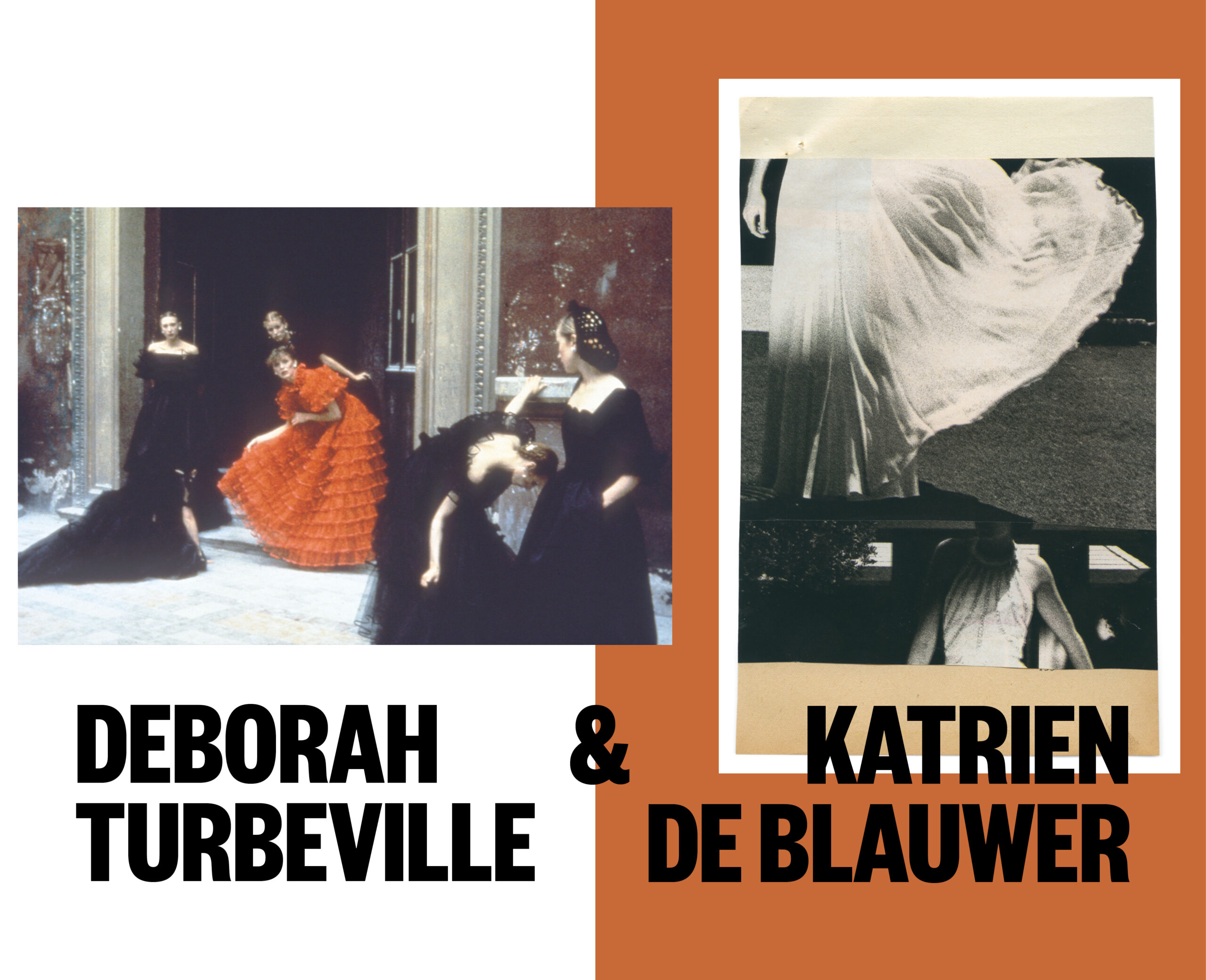
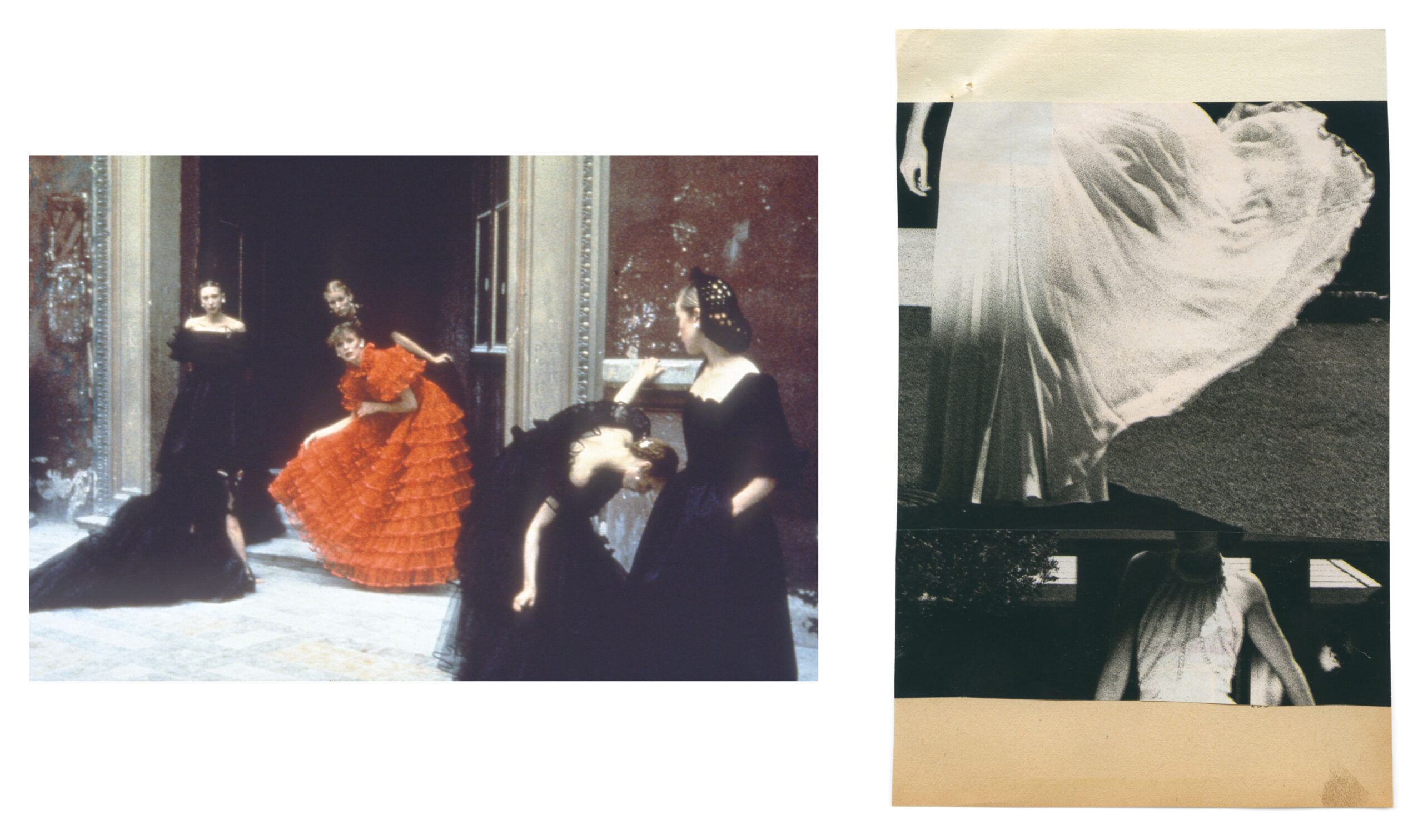
Deborah Turbeville (left)
'Untitled, (Valentino), Venice, Italy,' 1977
© Deborah Turbeville / MUUS Collection
Katrien de Blauwer (right)
'Girls 4', 2022
Courtesy of Galerie Les Filles du Calvaire, Paris
© Katrien de Blauwer
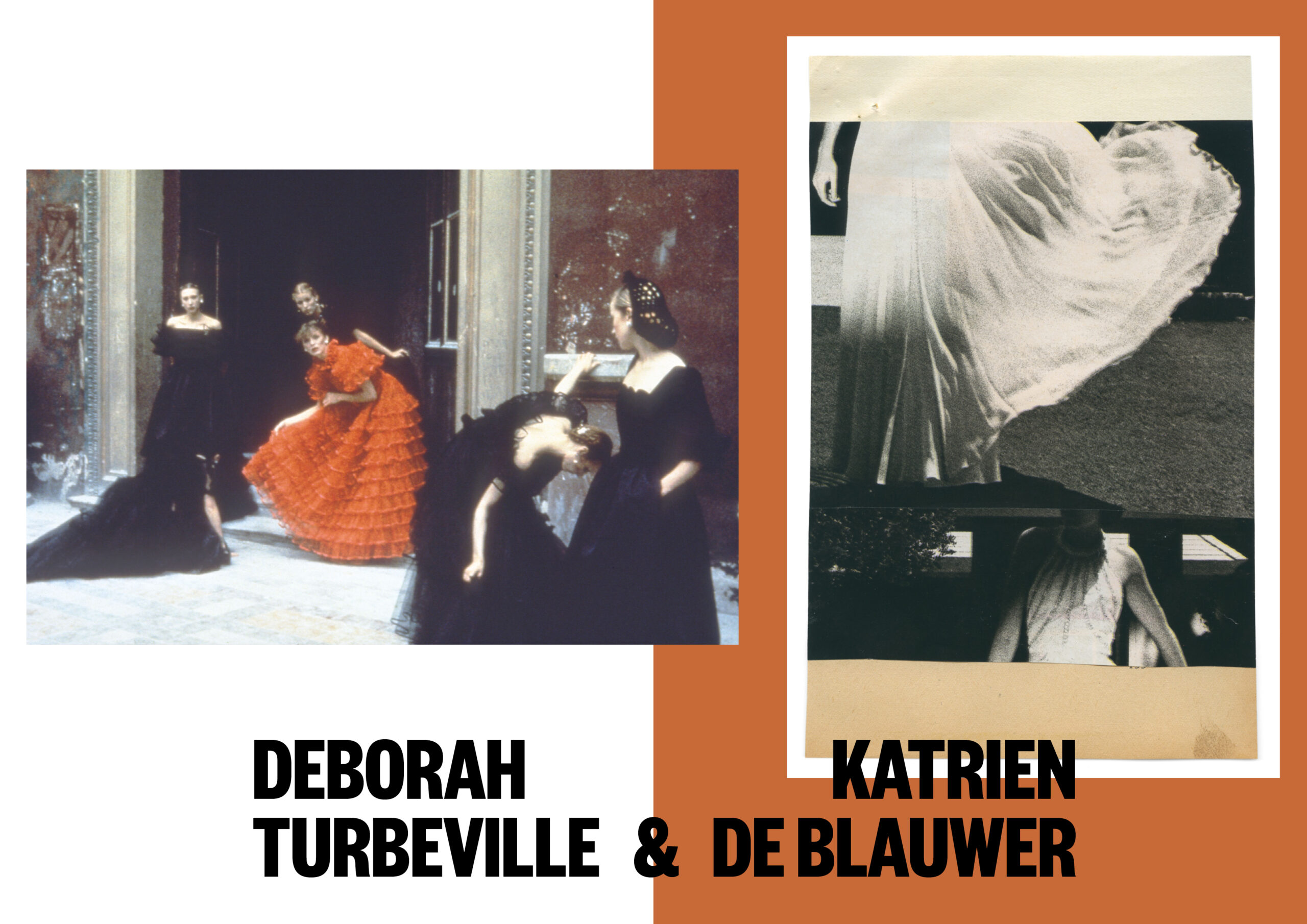

Deborah Turbeville (left)
'Untitled, (Valentino), Venice, Italy,' 1977
© Deborah Turbeville / MUUS Collection
Katrien de Blauwer (right)
'Girls 4', 2022
Courtesy of Galerie Les Filles du Calvaire, Paris
© Katrien de Blauwer
In Rhythmic
Dialogue
DEBORAH TURBEVILLE
Deborah Turbeville (1932 – 2013) was a renowned American fashion photographer known for her distinctive and avant-garde approach to photography. Turbeville’s work spans several decades from the 1970s through to her death in 2013, and was published in various fashion magazines and books, as well as exhibited in international museums and galleries.
KATRIEN DE BLAUWER
Belgian artist Katrien De Blauwer (b. 1969) is internationally recognized and has exhibited widely. Her first book Inappropriate repetitions came out in 2012 and she now has ten publications to her name. Her major exhibitions include Les photos qu’elle ne montre à personne, Rencontres d’Arles (Fr, 2022) and Isabelle is 24… Isaelle is 42, Musée des Beaux-Arts Le Locle (MBAL) (CH, 2020).
DEBORAH TURBEVILLE
Deborah Turbeville (1932 – 2013) was a renowned American fashion photographer known for her distinctive and avant-garde approach to photography. Turbeville’s work spans several decades from the 1970s through to her death in 2013, and was published in various fashion magazines and books, as well as exhibited in international museums and galleries.
KATRIEN DE BLAUWER
Belgian artist Katrien De Blauwer (b. 1969) is internationally recognized and has exhibited widely. Her first book Inappropriate repetitions came out in 2012 and she now has ten publications to her name. Her major exhibitions include Les photos qu’elle ne montre à personne, Rencontres d’Arles (Fr, 2022) and Isabelle is 24… Isaelle is 42, Musée des Beaux-Arts Le Locle (MBAL) (CH, 2020).
This online exhibition brings together the work of two female artists whose careers are separated by half a century. Despite never having met, they seemingly embody the same inner spirit.
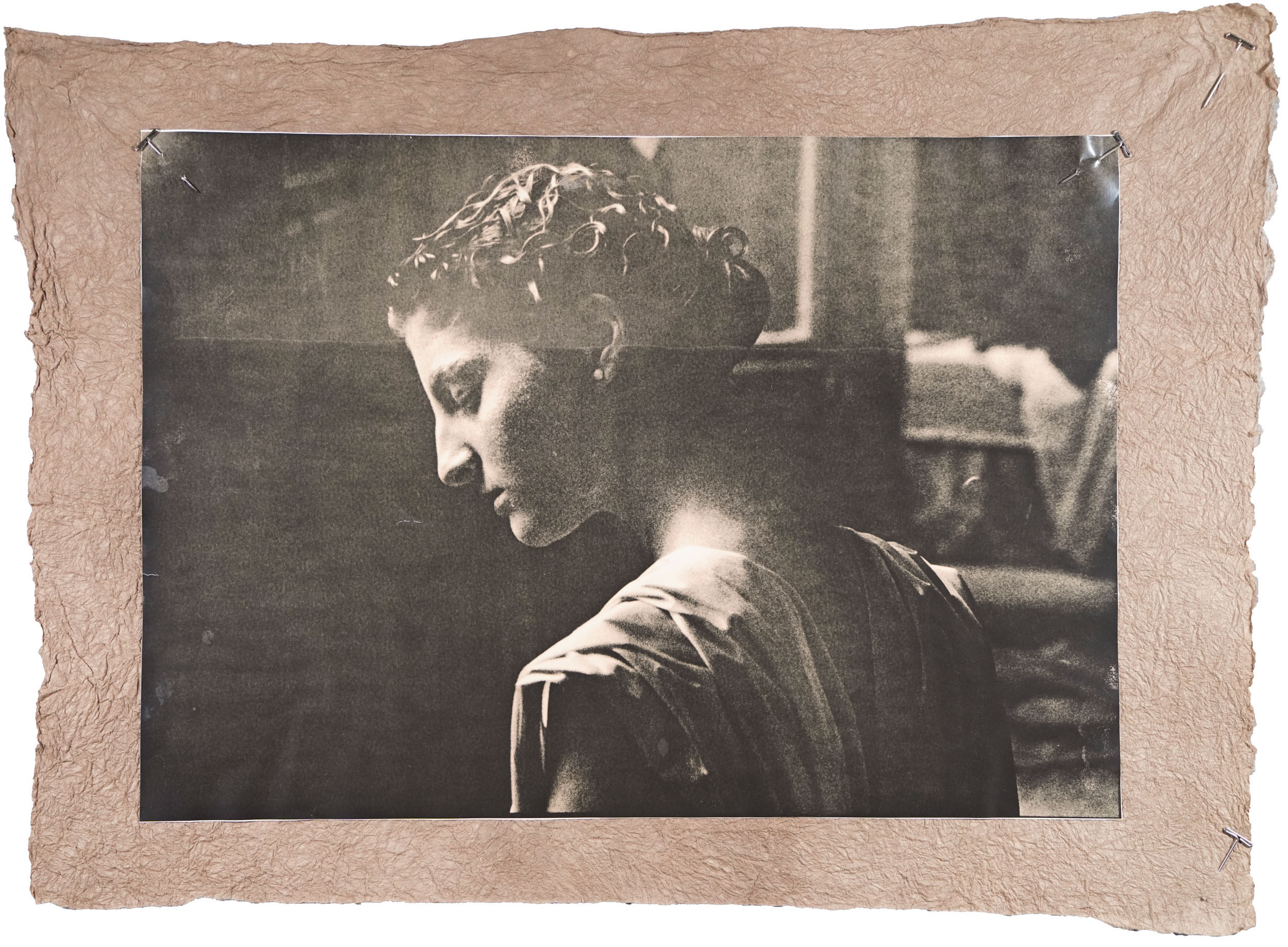

© Deborah Turbeville / MUUS Collection
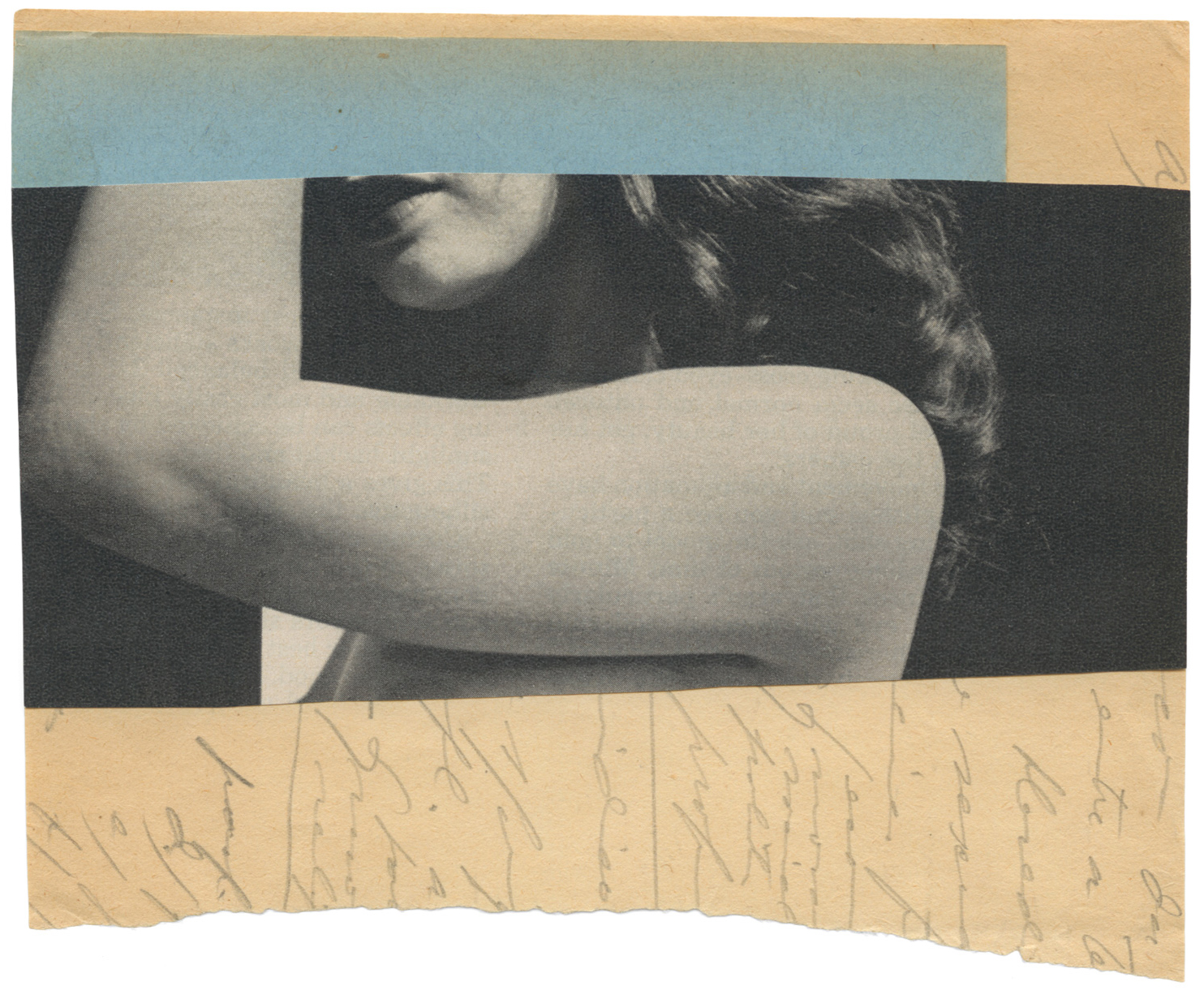

Collage, Unique
Courtesy of Galerie Les Filles du Calvaire, Paris
© Katrien de Blauwer
“I have known the photography of Deborah Turbeville for a long time through the Steidl publication Past Imperfect and always admired it profoundly.”
_ KATRIEN DE BLAUWER, NOV 2023
I had two fascinating conversations with Katrien de Blauwer, the first at Paris Photo last November and a follow-up last month. We discussed aspects of her more personal projects like the publication When I Was a Boy (2018), and the approach to storytelling in Turbeville’s work. Katrien mentioned her large collection of notebooks with image cuttings and their affinity with the private notebooks and sketches Turbeville created through her life. She also spoke about her appreciation of Turbeville’s rough destruction of prints alongside her own attraction to old papers.
Inspired by my experience at the MUUS Collection and my conversations with Katrien, I started to delve deeper, and more connections emerged: recurring themes in their imagery, the influence of New Wave cinema on their approach to narrative, the performative aspect of how they create their work. It was almost uncanny. Here is what I found most beautiful and poignant in their parallel paths.
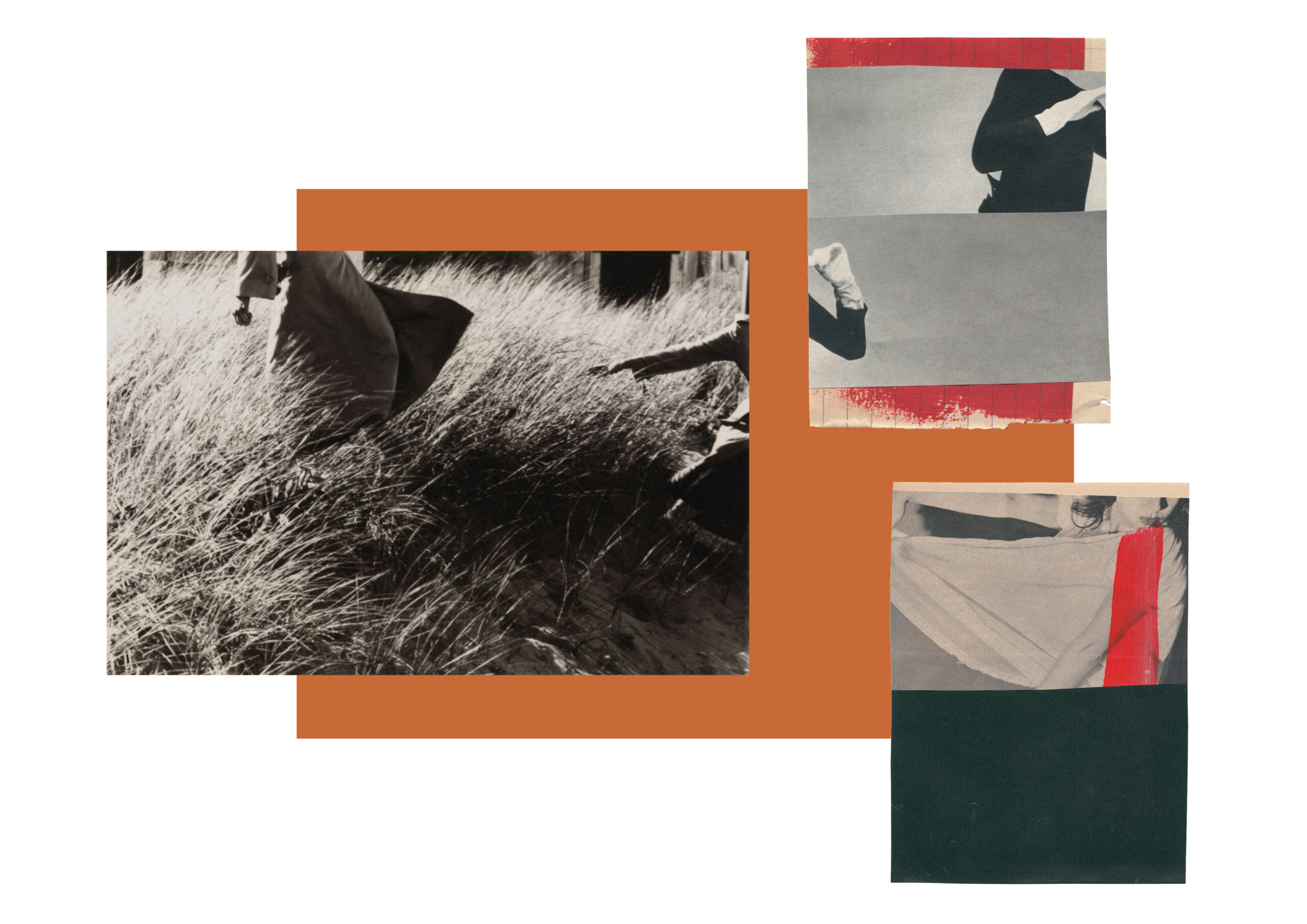
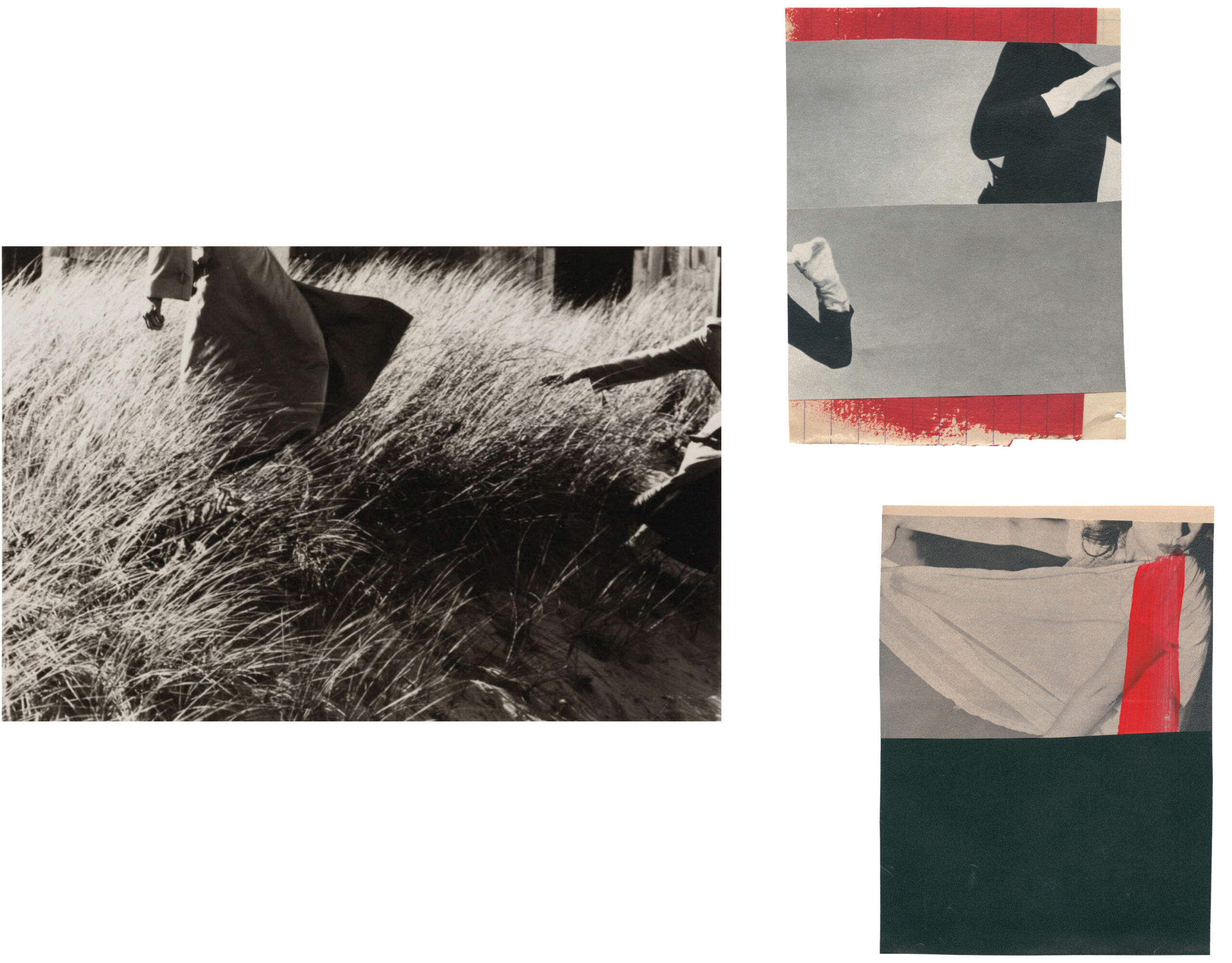
Deborah Turbeville (left)
Untitled, from the series ‘Block Island’, Block Island, Rhode Island, 1976
© Deborah Turbeville / MUUS Collection
Katrien de Blauwer (right)
'Painted Scenes 18', 2017 (top)
'Painted Scenes 29', 2018 (bottom)
Courtesy of Galerie Les Filles du Calvaire, Paris
© Katrien de Blauwer
A DISTINCTIVE VOICE


Collage, Unique
Courtesy of Galerie Les Filles du Calvaire, Paris
© Katrien de Blauwer
“Ever since I was a child, there was a voice inside me, who told me I was not like the rest.”
_ KATRIEN DE BLAUWER, JANE MAGAZINE, 2017
“It is because of will. It takes will, for anyone who’s exploratory, inventive, to oppose the conventions, the norms”
_ DEBORAH TURBEVILLE, VOGUE, 1981


© Deborah Turbeville / MUUS Collection
“A breaking away and metamorphosis,” is how Katrien De Blauwer describes her time at the Royal Academy in Antwerp, where she went to escape her home and troubled childhood. A fashion student, it was there that she made her first collage books as studies and mood-books for fashion collections. She soon abandoned fashion to pursue a career as an artist, but her interest in fashion remained, particularly for the aesthetic and glossy styling of the 1960s and 70s. In these images, she said she finds a freedom and has even relied on them as a means of searching for her own femininity. At the same time, through her process of cutting and gluing, she disrupts and reinterprets her source material, cultivating a different atmosphere entirely.
Eschewing categorization, de Blauwer’s work explores photography, painting, fashion and cinema, sometimes all in one image. She spends a lot of time in the past, immersed in old books and magazines. But through her daring image choices, she gives her source material new meaning. Female figures predominate but remain elusive; enigmatic, tense scenes unfold with a cinematic feel; black and white tones against textured, worn yellowing papers assume a patina. Her artworks are unique in their ability to reveal things by cutting parts away.
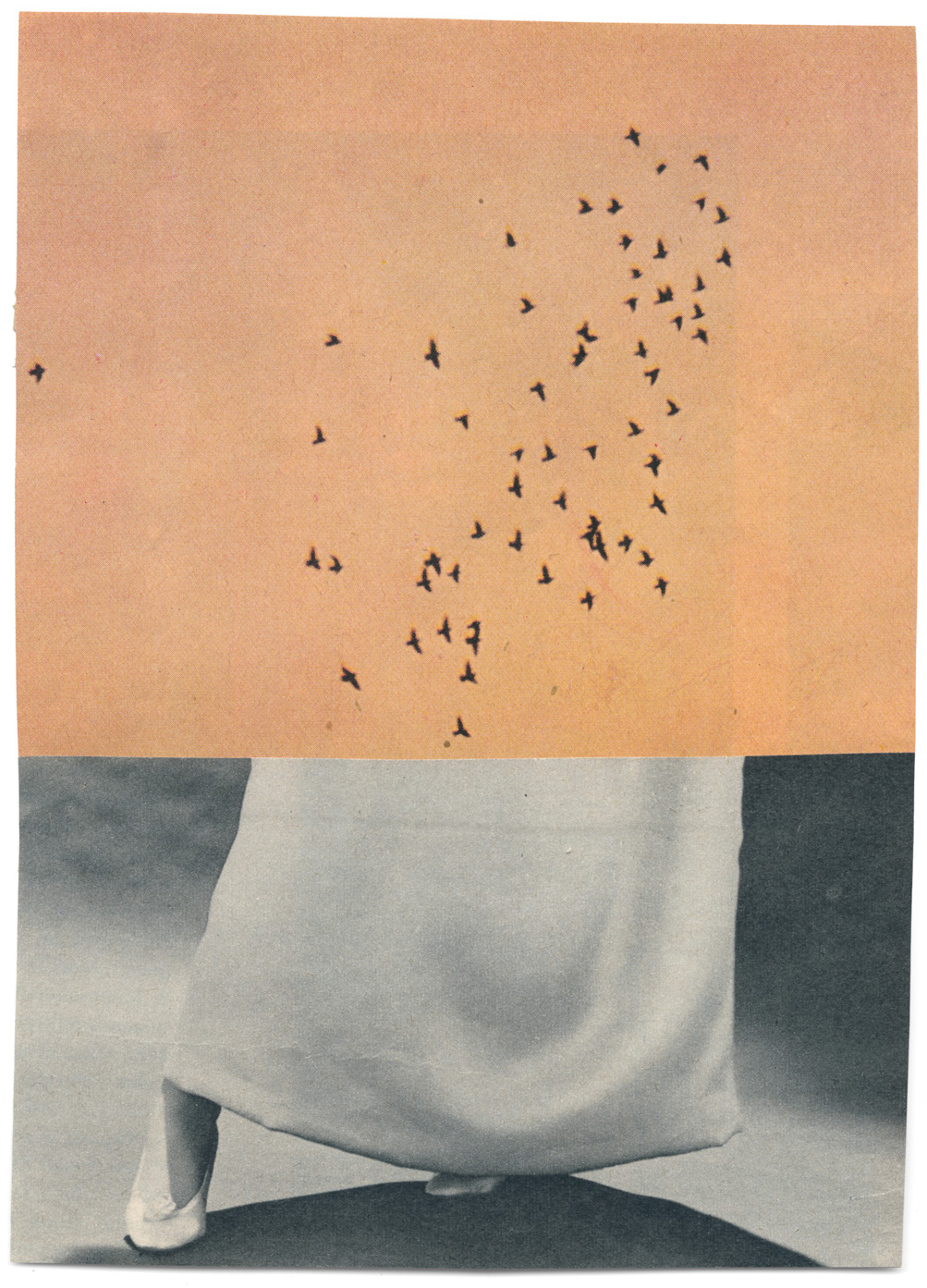

Collage, Unique
Courtesy of Galerie Les Filles du Calvaire, Paris
© Katrien de Blauwer
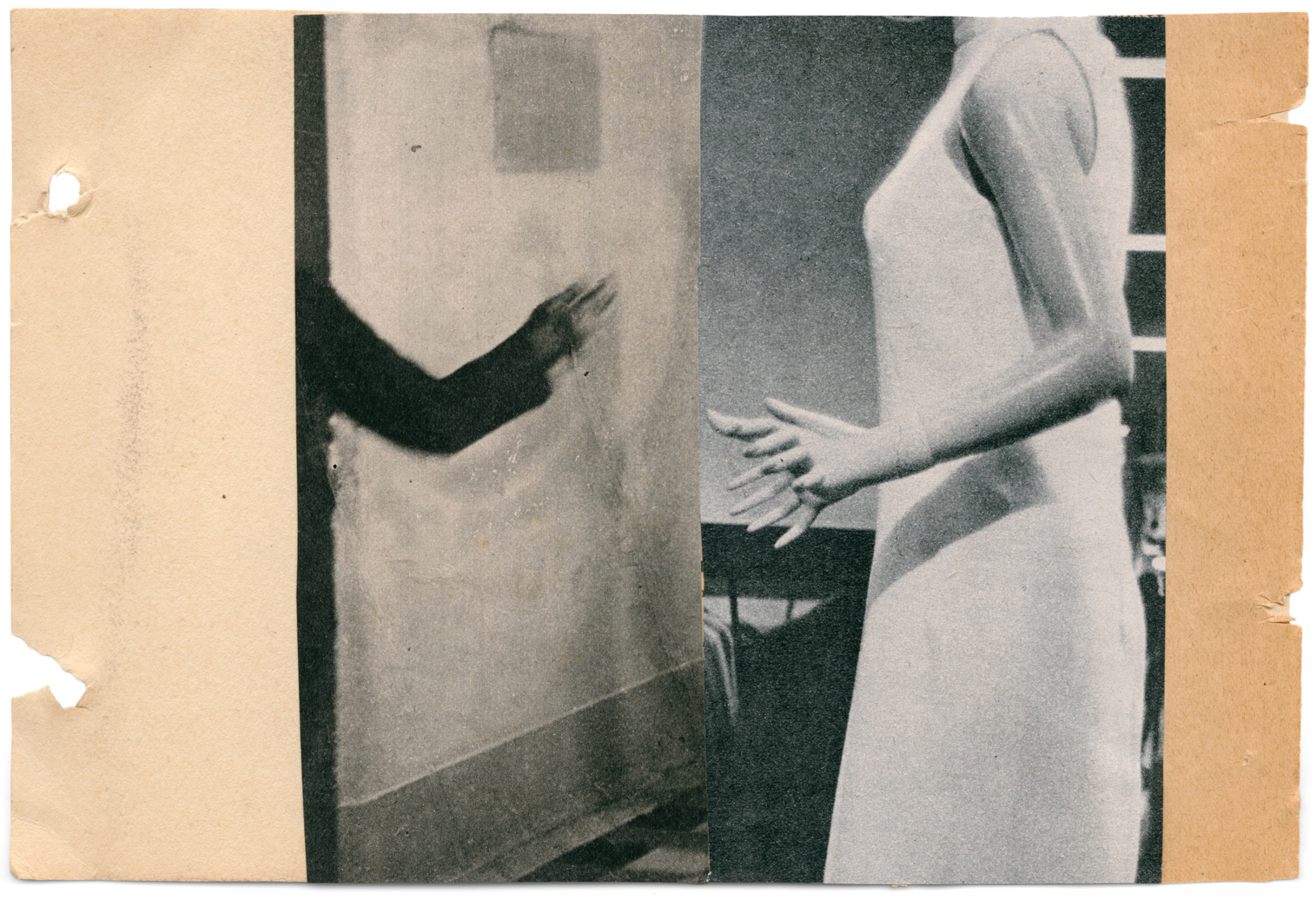

Collage, Unique
Courtesy of Galerie Les Filles du Calvaire, Paris
© Katrien de Blauwer
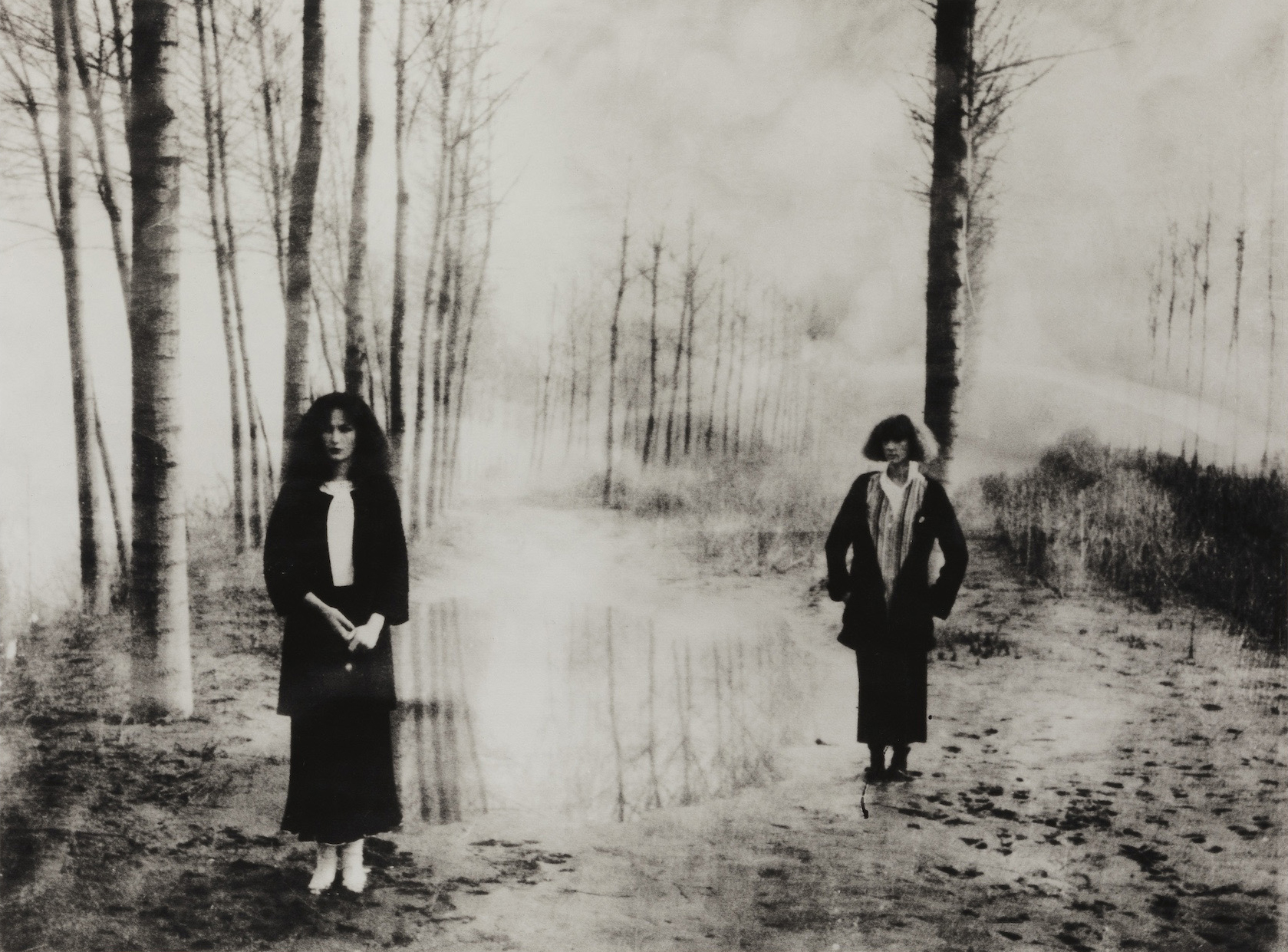

© Deborah Turbeville / MUUS Collection
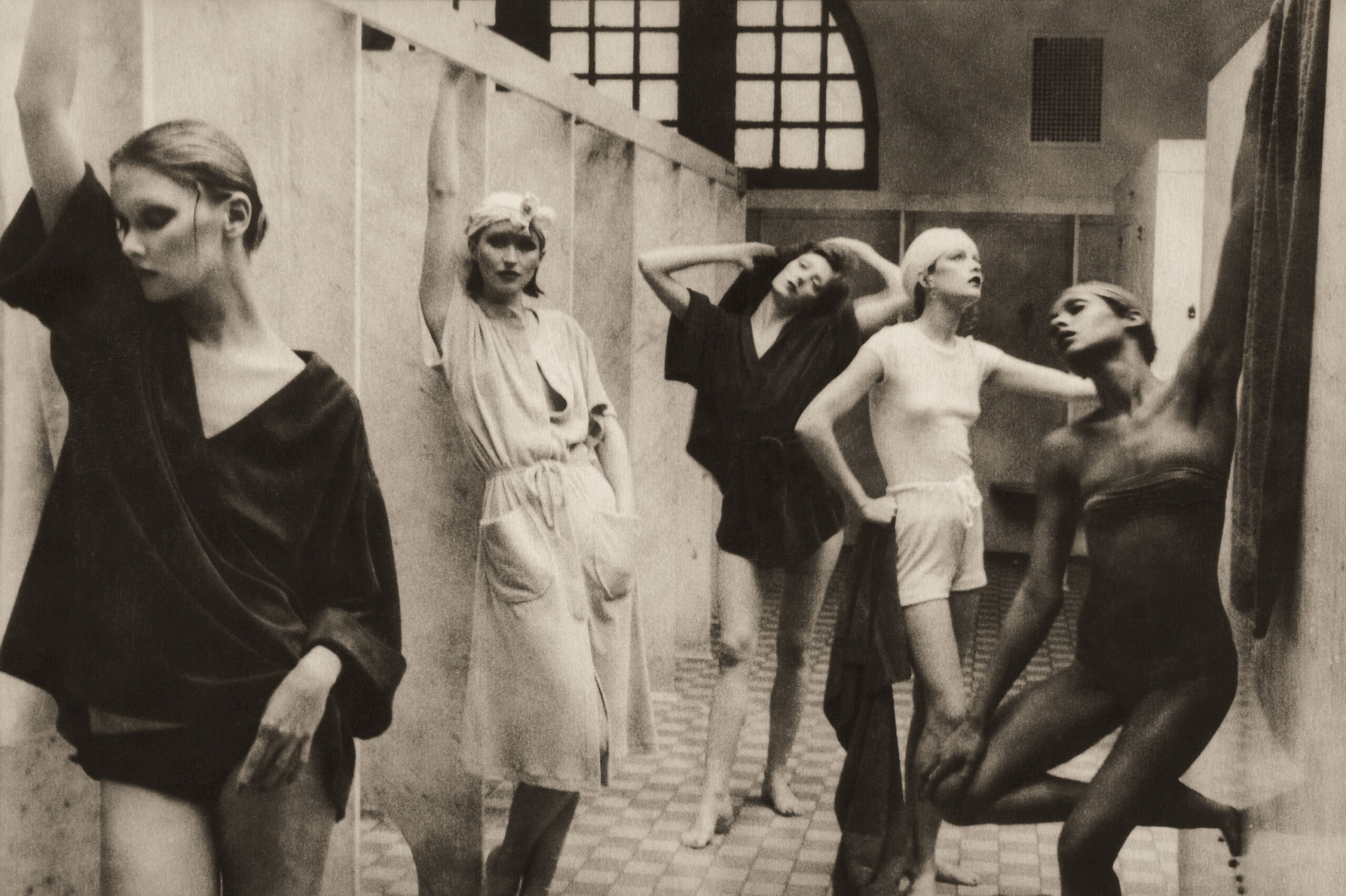

© Deborah Turbeville / MUUS Collection
Turbeville’s photographs often look like they were made in an earlier century. Inspired by Julia Margaret Cameron, her signature soft-focus and muted tones are reminiscent of Pictorialism, the Victorian photographic movement. Altering her prints to be damaged or destroyed, worn, faded and grainy, she further broke away from the perfection – and commerciality – of fashion imagery typical of the time. Today, where our eyes are attuned to clean and polished digital imagery, their physicality and imperfections are particularly striking.
IDENTITY & SOLITUDE
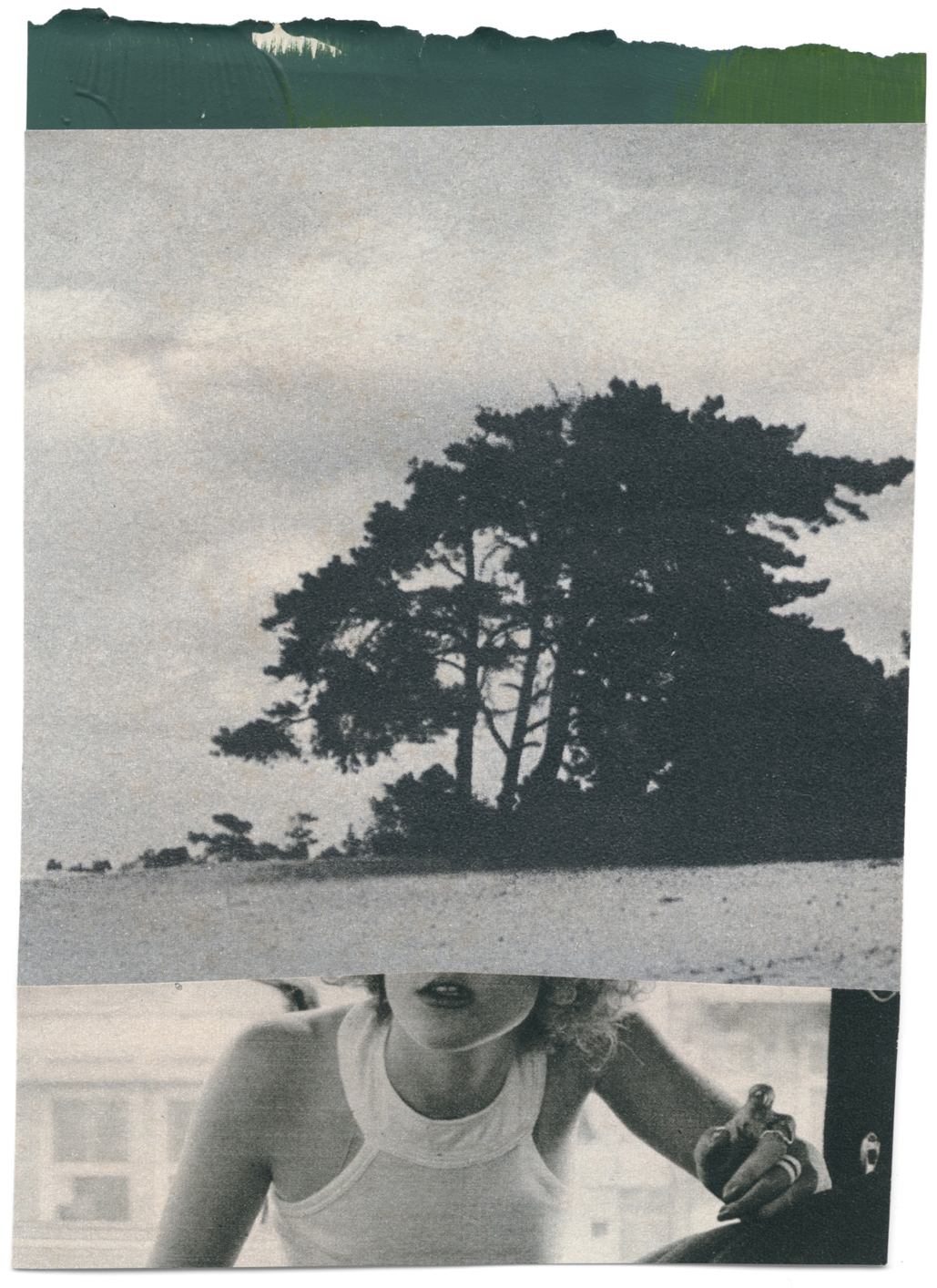

Collage, Unique
Courtesy of Galerie Les Filles du Calvaire, Paris
© Katrien de Blauwer
“My work confronts me with myself… as a kind of mirror and tool to explore myself.”
_ KATRIEN DE BLAUWER, ANAISE, 2019
“I’m like the women in my photographs – a little bit anxious and spooked and insecure. In certain ways out of balance with my times.”
_ DEBORAH TURBEVILLE, ARTOGRAPH, 1982
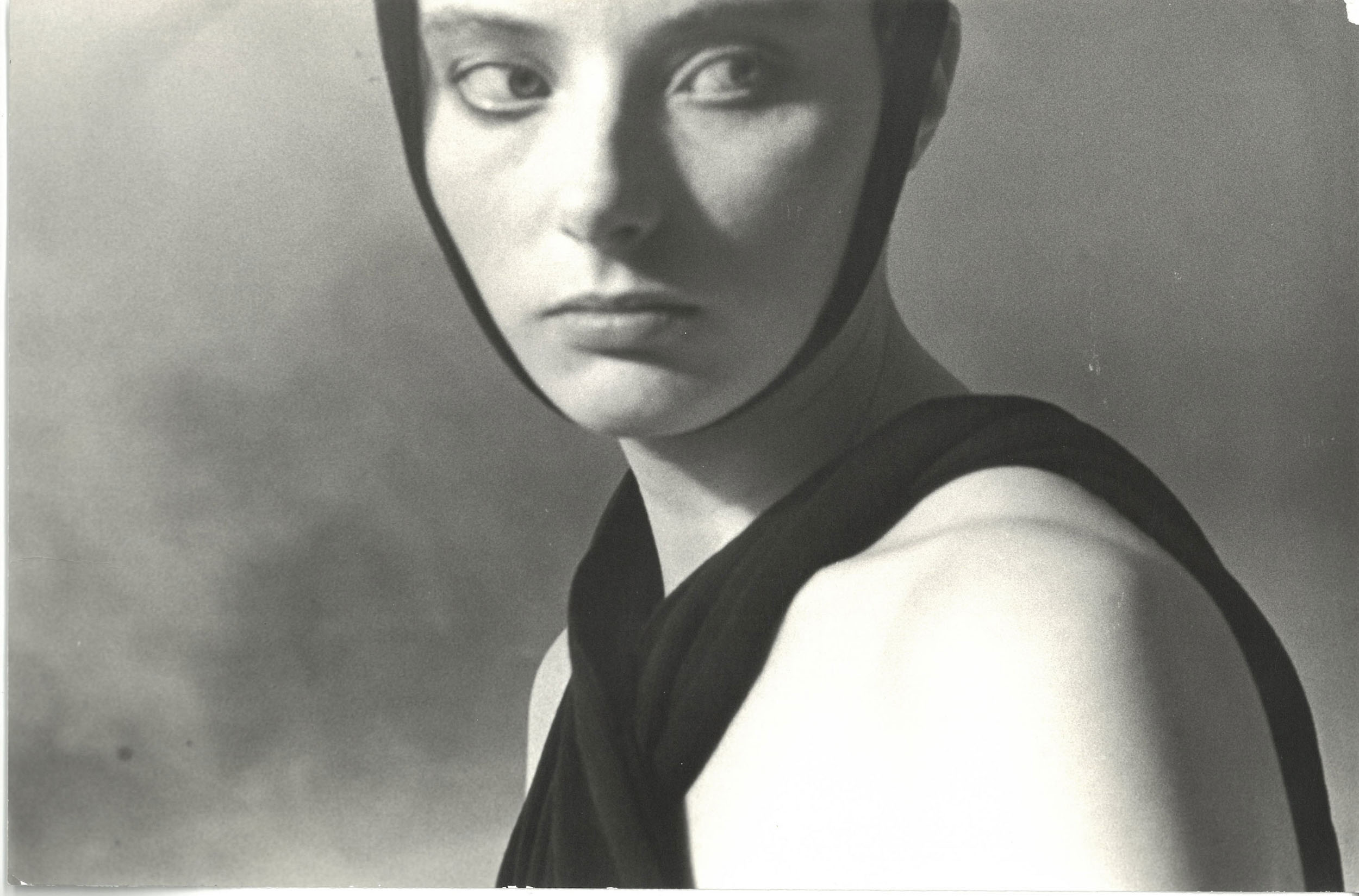
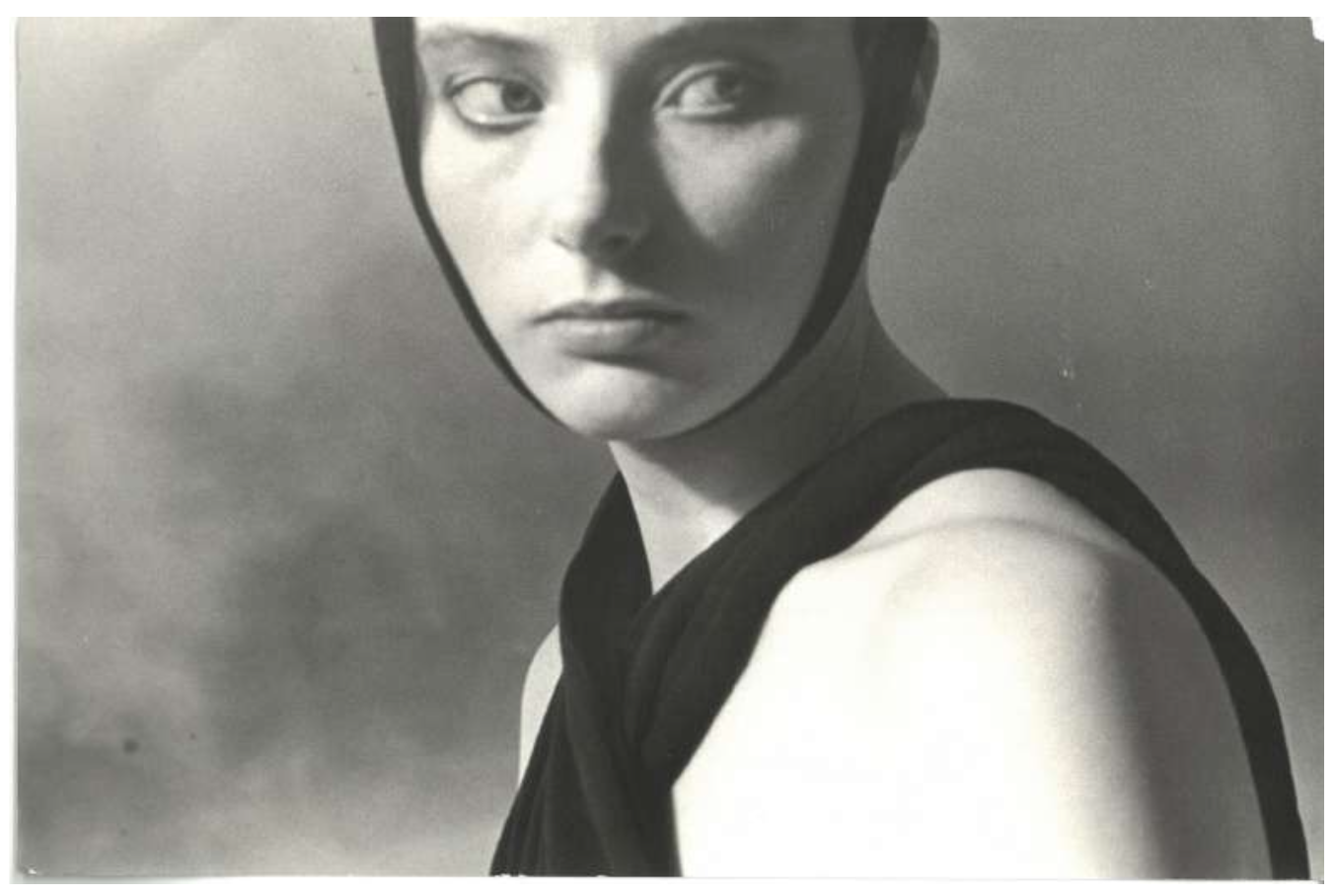
© Deborah Turbeville / MUUS Collection
De Blauwer describes the selection of images to create her female-dominated worlds as a means of asking herself questions about her body, identity and sexuality. Her most personal and autobiographical series, When I Was a Boy (2018), tells the story of her childhood and sees her diving deeply into her own identity and relationship to gender. Raised by her grandmother, who lost a male child in infancy, De Blauwer became a kind of proxy in boys clothes and short hair. When she reached puberty and her body began to change, her grandmother rejected her completely. Unsurprisingly, the transformation to a female identity was a struggle for the artist. Katrien told me that, unlike some of her other female characters whom she hides behind, those from When I Was a Boy became a part of her.
An intensely private person, De Blauwer prefers to work alone in her studio, channeling her emotions directly into her work. Conceptually, her subject matter is often driven by her own experiences, but her use of found images and cropping so that only a figure’s hair, mouth or fleeting gesture is visible, makes her subjects impossible to identify. This is also what gives her audience the space to connect with them. “At my exhibitions, people look at the work and bring their own stories”, she says. Sometimes the result can be heavy, de Blauwer admits, but she is gratified by how her work touches people.
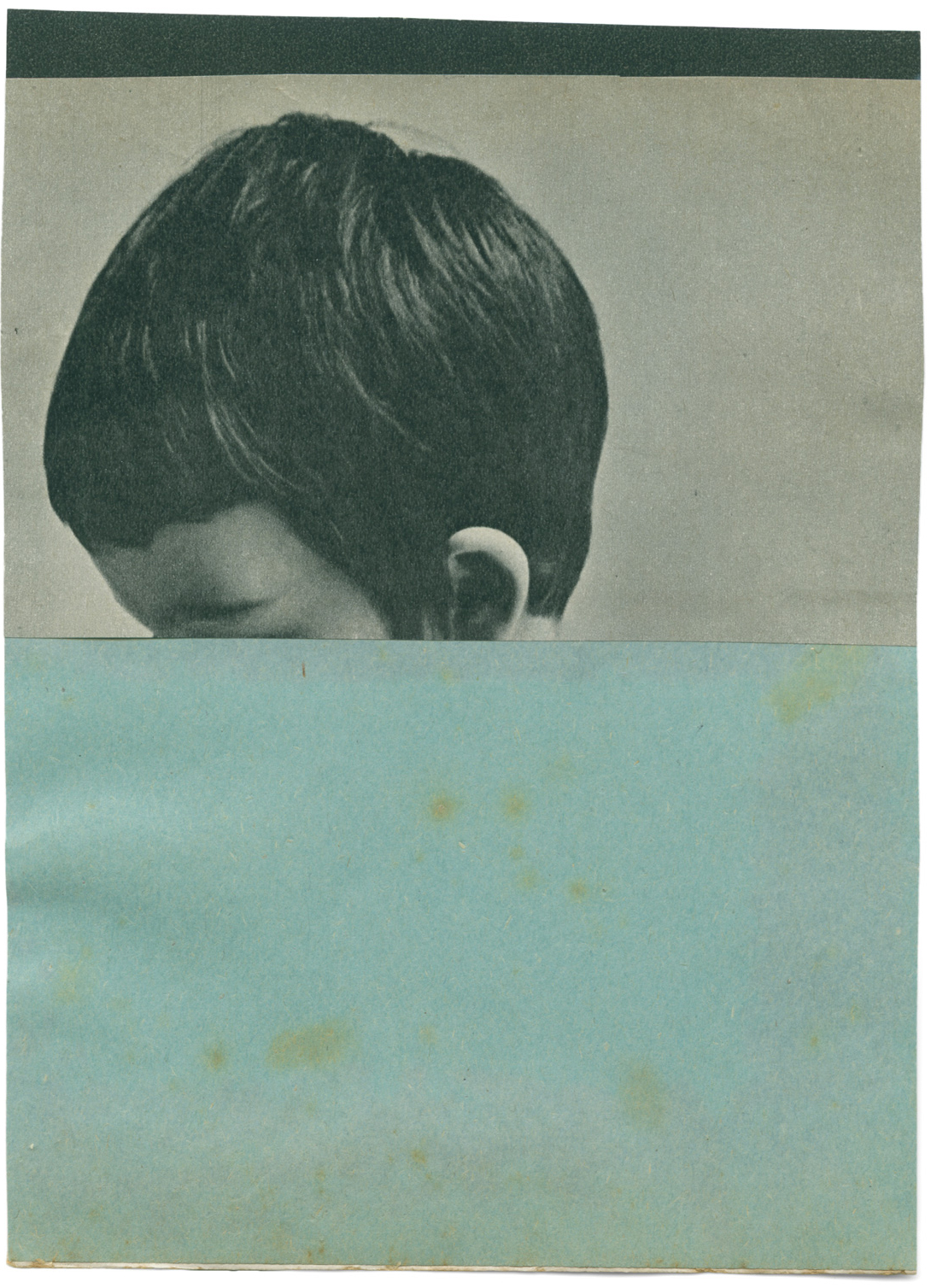

Collage, Unique
Courtesy of Galerie Les Filles du Calvaire, Paris
© Katrien de Blauwer
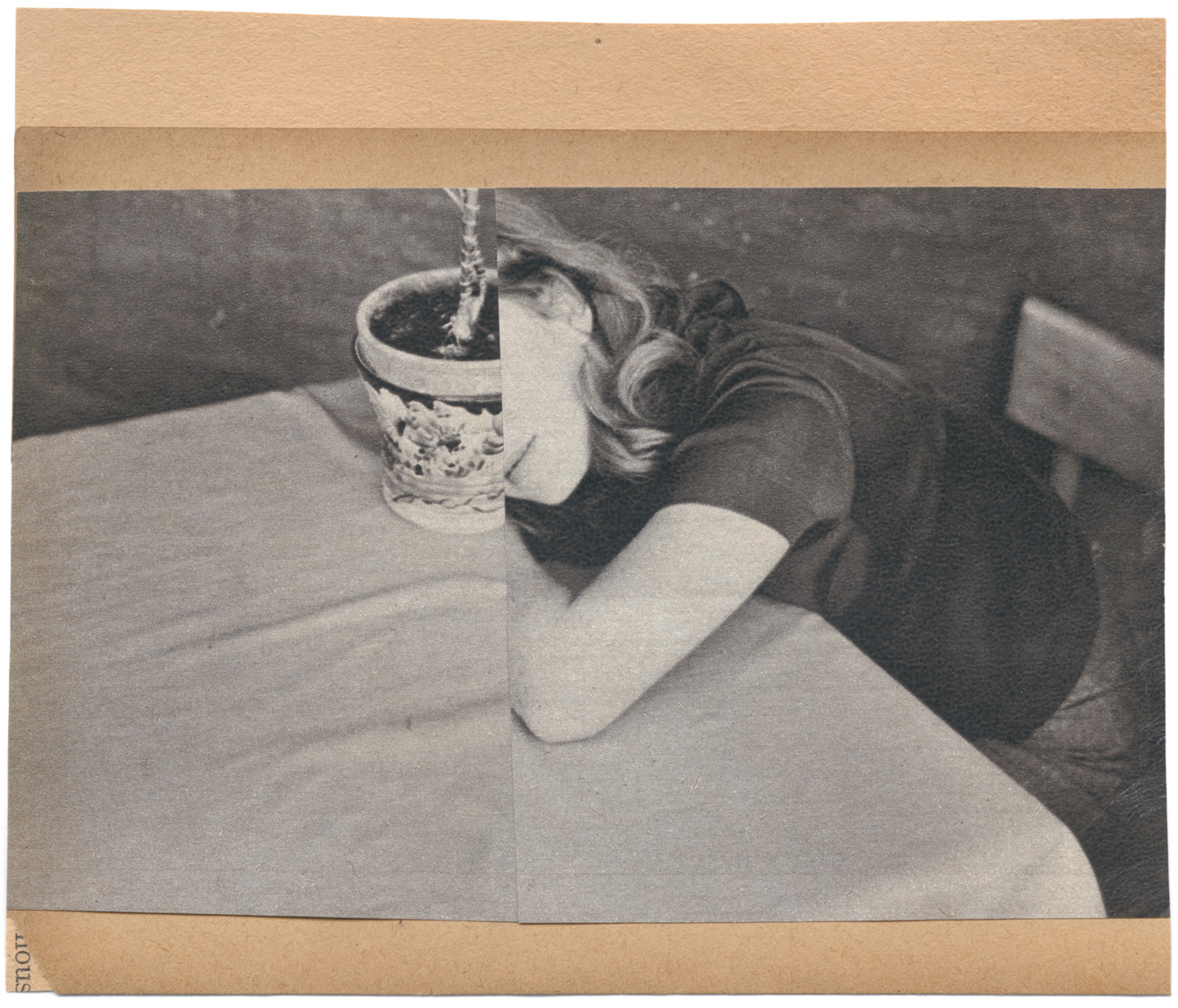

Collage, Unique
Courtesy of Galerie Les Filles du Calvaire, Paris
© Katrien de Blauwer
Much of Deborah Turbeville’s work also centres around solitary women. She captures them as passive or detached, looking away or down, appearing as outsiders – qualities she associated with. She described herself as, “…terribly self-conscious. I am afraid often, of people…” (Vogue, 1981). Perhaps it was this introspection that allowed Turbeville to make such deeply personal work. Her models often even looked like her, with similar faces and hair.
Like de Blauwer, Turbeville’s work has a quality of being simultaneously intimate and anonymous. Through the use of cropped elements, they too suggest rather than overtly tell a story, inviting viewers to project their own meanings onto the images.
Around 1990, Turbeville created the visual accompaniment to her novella Passport, which comprised more than 130 collages, including excerpts lifted from the text. The story of a successful fashion designer, Alix P., who has a breakdown and disappears at the peak of her career, the satirical novella was inspired by Turbeville’s experiences working in the fashion industry. These works aren’t easy, but rather disorientating and somber. Their strange, raw beauty reveal her instinctive approach and ability to portray the complex, multi-faceted nature of her female characters.
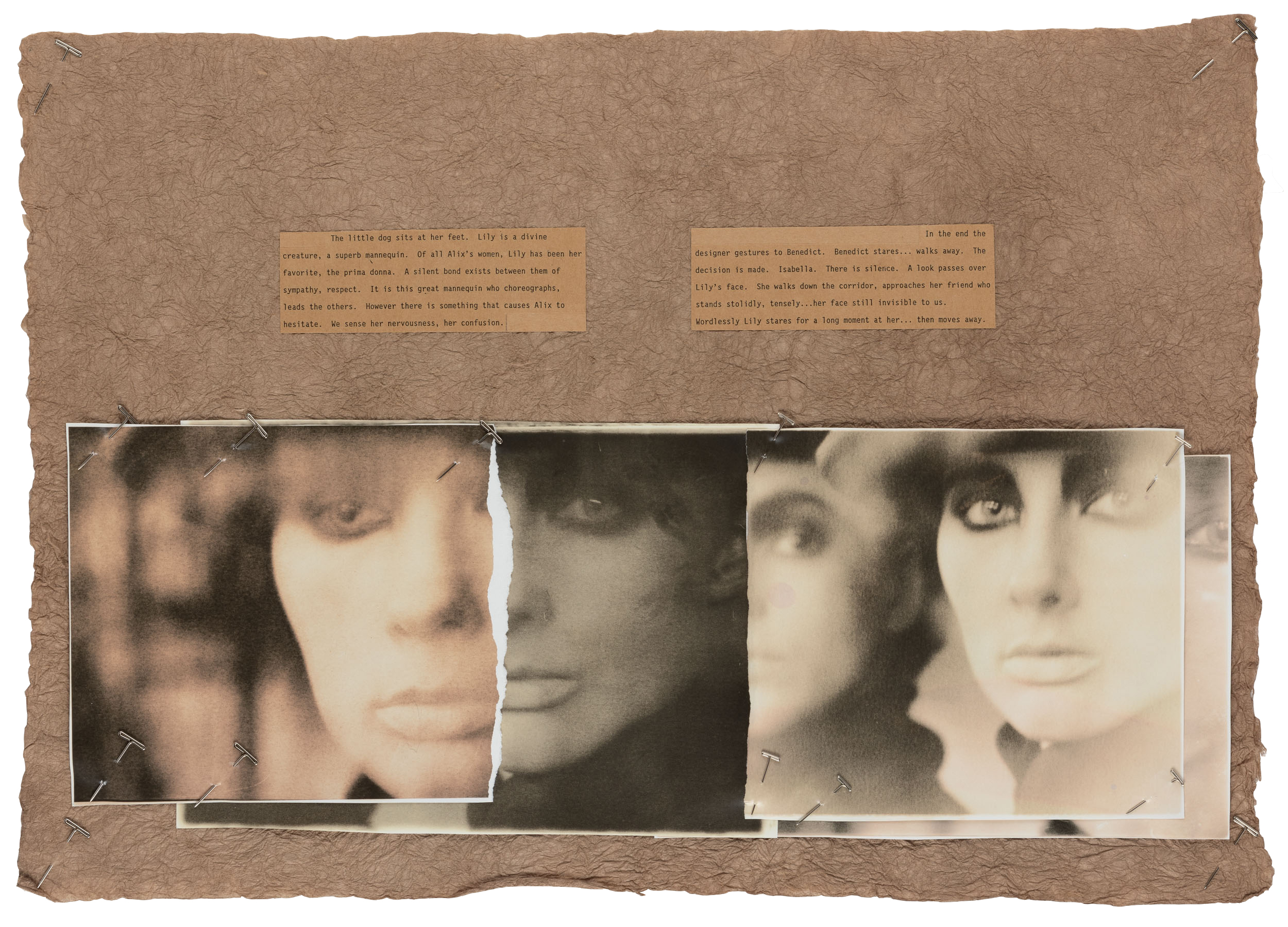

© Deborah Turbeville / MUUS Collection
DECONSTRUCTION & RECONSTRUCTION
"I look in a magazine and I enter a whole different history…then I take this history, and bring it back to the present moment, knowing that it will eventually move into a future that I don’t know.”
_ KATRIEN DE BLAUWER, FOLIE SPACE, 2020
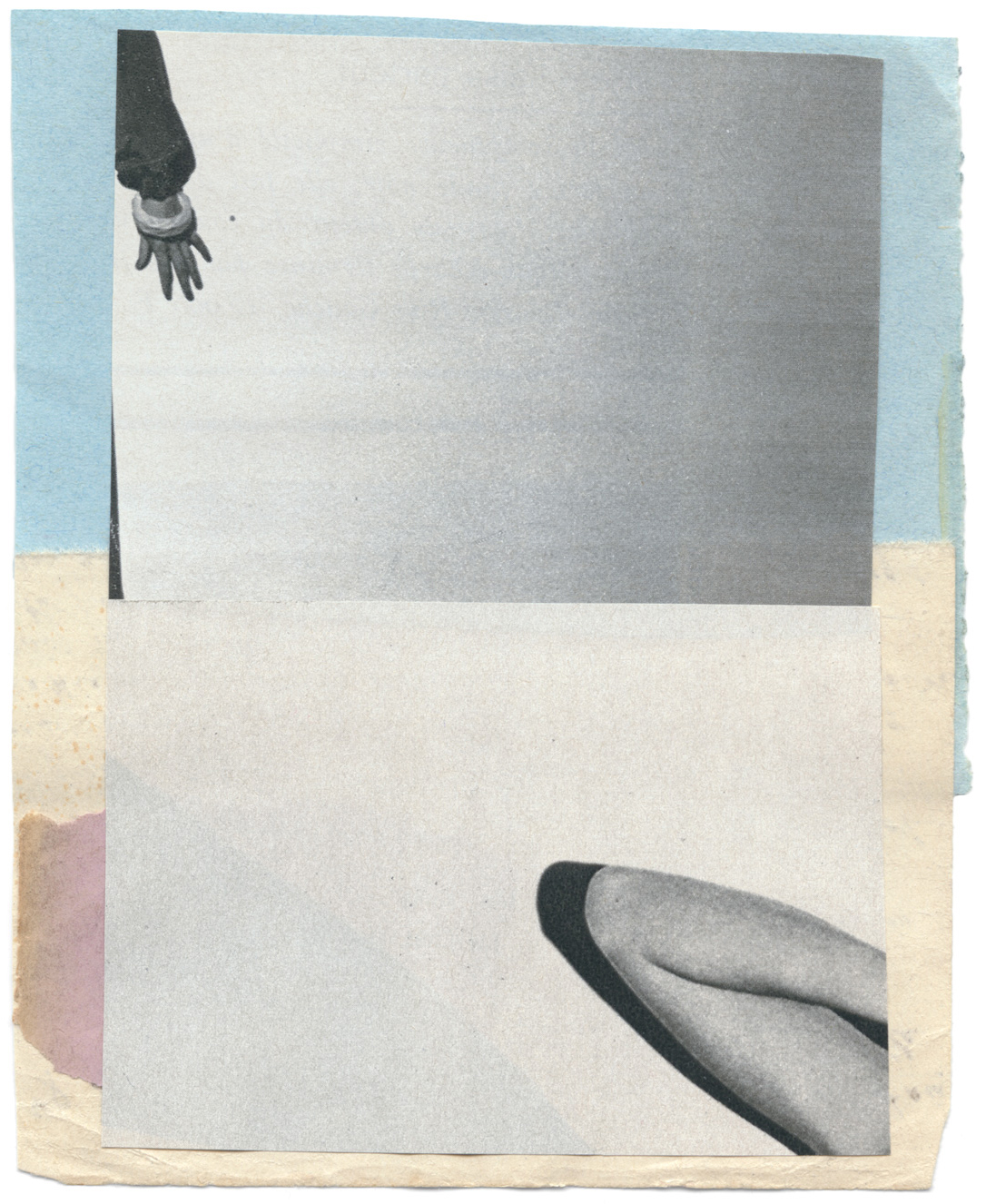

Collage, Unique
Courtesy of Galerie Les Filles du Calvaire, Paris
© Katrien de Blauwer
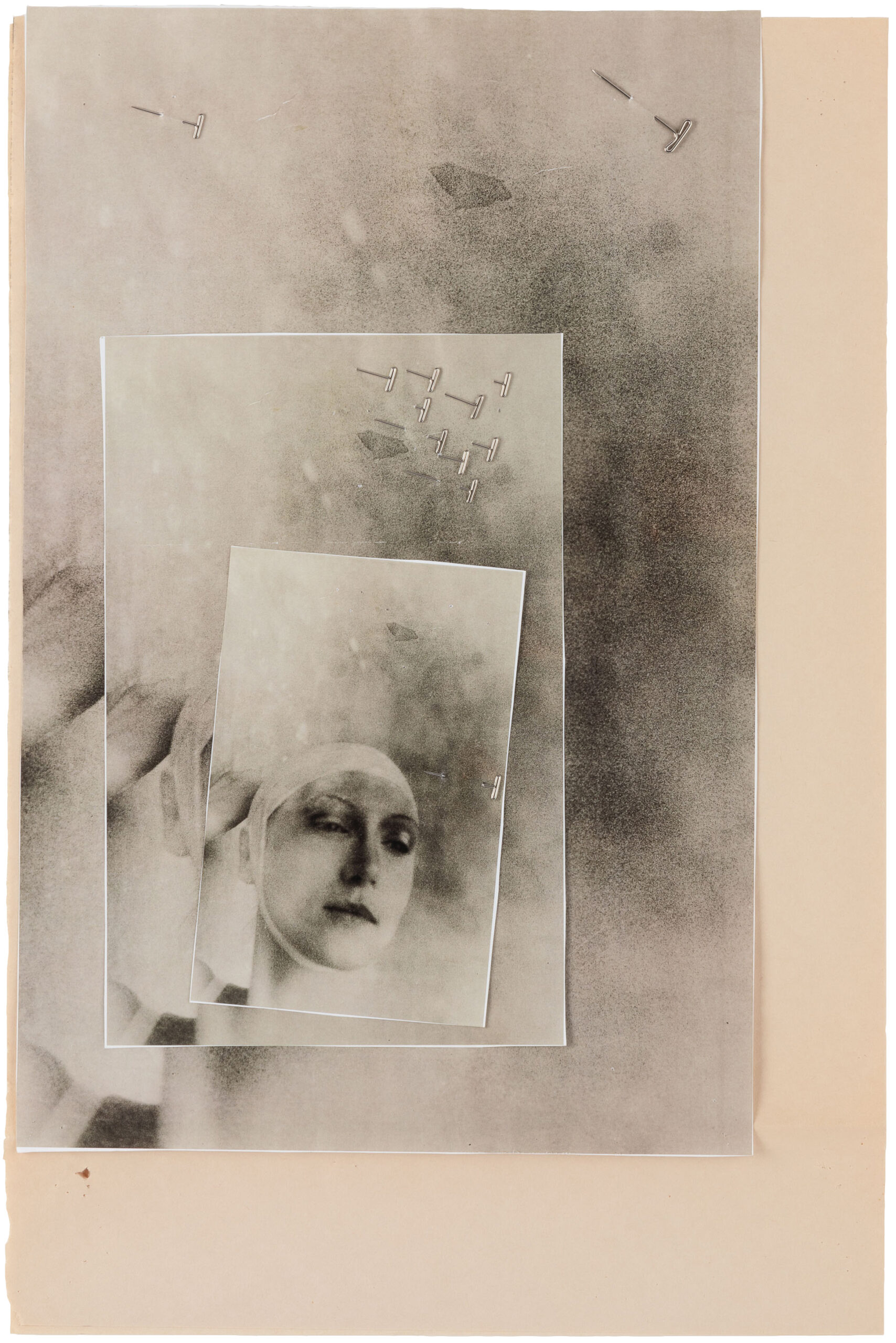

© Deborah Turbeville / MUUS Collection
"I destroy the image after I’ve made it. The idea of disintegration is really the core of my work."
_ DEBORAH TURBEVILLE, INTERVIEW MAGAZINE, 2012
De Blauwer has described her intense and experimental working process as wholly intuitive and very physical – placing images on her worktable, trying out combinations, cutting with scissors or tearing out pictures, occasionally adding a long mark of pastel or a thick stroke of paint. She has compared the process to that of being a dancer. “Those exercises, the repetition, the concentration, the endurance, the discipline, the obsession…that is also in my work.” (De Standaard, 2020) It is only when something is finished that she can step back and start to understand what’s there.
Drawn to paper that is faded or aged, with stains and marks, the distressed surfaces trace memories that also speak to the physicality of de Blauwer’s process. Her series Jump Cuts, whose title references the innovative film technique used in the 1960 film Breathless, has the same sense of disjunction and temporal movement that can be seen in much of her work with its split, rhythmic patterns. The echoes feel like recollections from the past that resurface and linger in our minds.
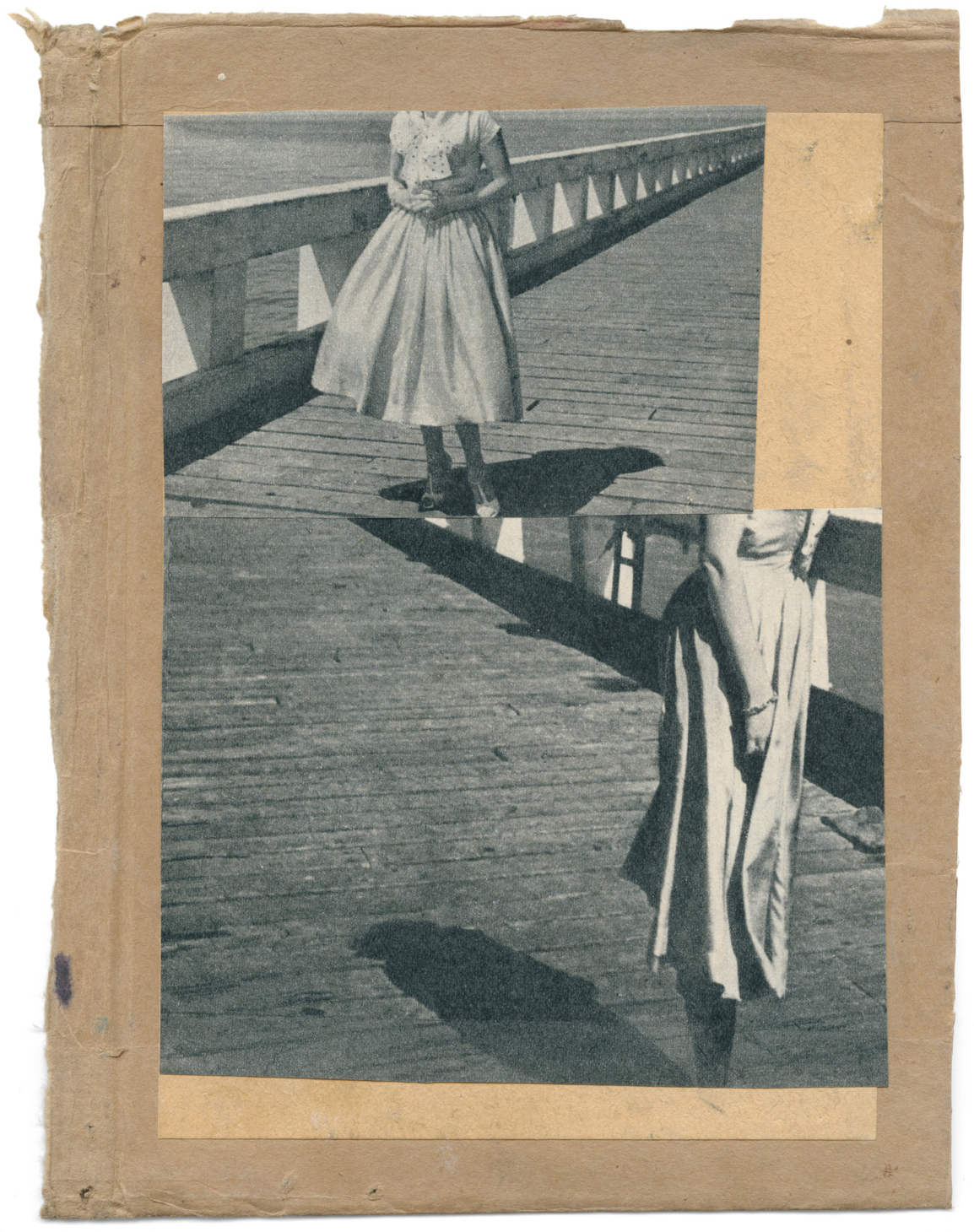

Collage, Unique
Courtesy of Galerie Les Filles du Calvaire, Paris
© Katrien de Blauwer
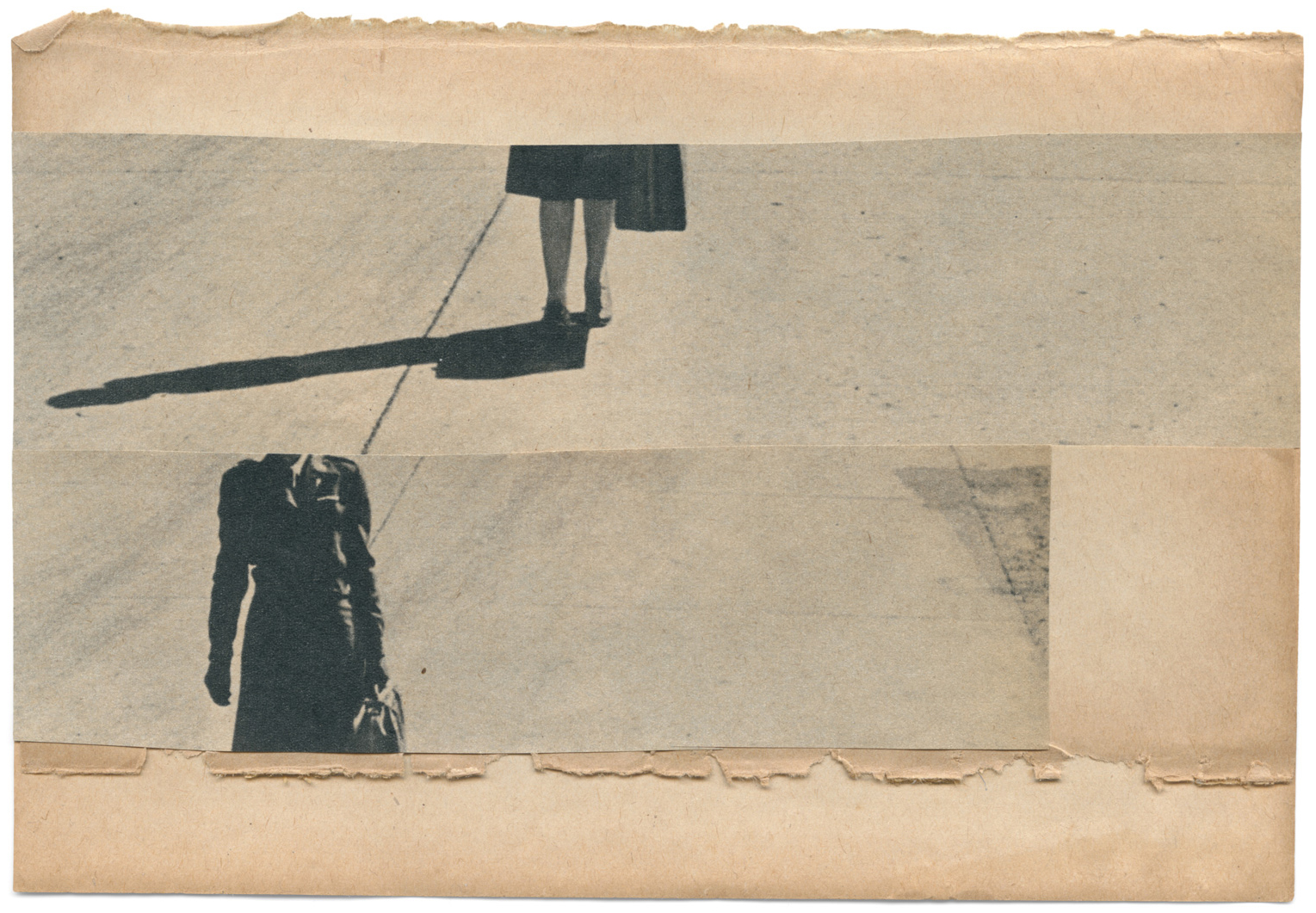

Collage, Unique
Courtesy of Galerie Les Filles du Calvaire, Paris
© Katrien de Blauwer
Turbeville experimented in both her photography and printing to achieve a particular materiality and evoke certain emotions, the culmination of which can be seen in the Passport collages. Revisiting her archives for material, she selected negatives and contact sheets, exploring different exposures and printing techniques including sepia tones and negative images. Her arrangements of small, fragile prints range from light, solarized and ghostly impressions to darker toned, sharper depictions. Her working process took on a hand-made and performative aspect: cutting with scissors, tearing, overlapping and repeating, before constructing the compositions with pins and sticky tape, all presented on her signature rough brown paper. The rawness and fragility of these works, pushed towards ‘obliteration’, are a daring way to capture the intricate layers of history and memory.
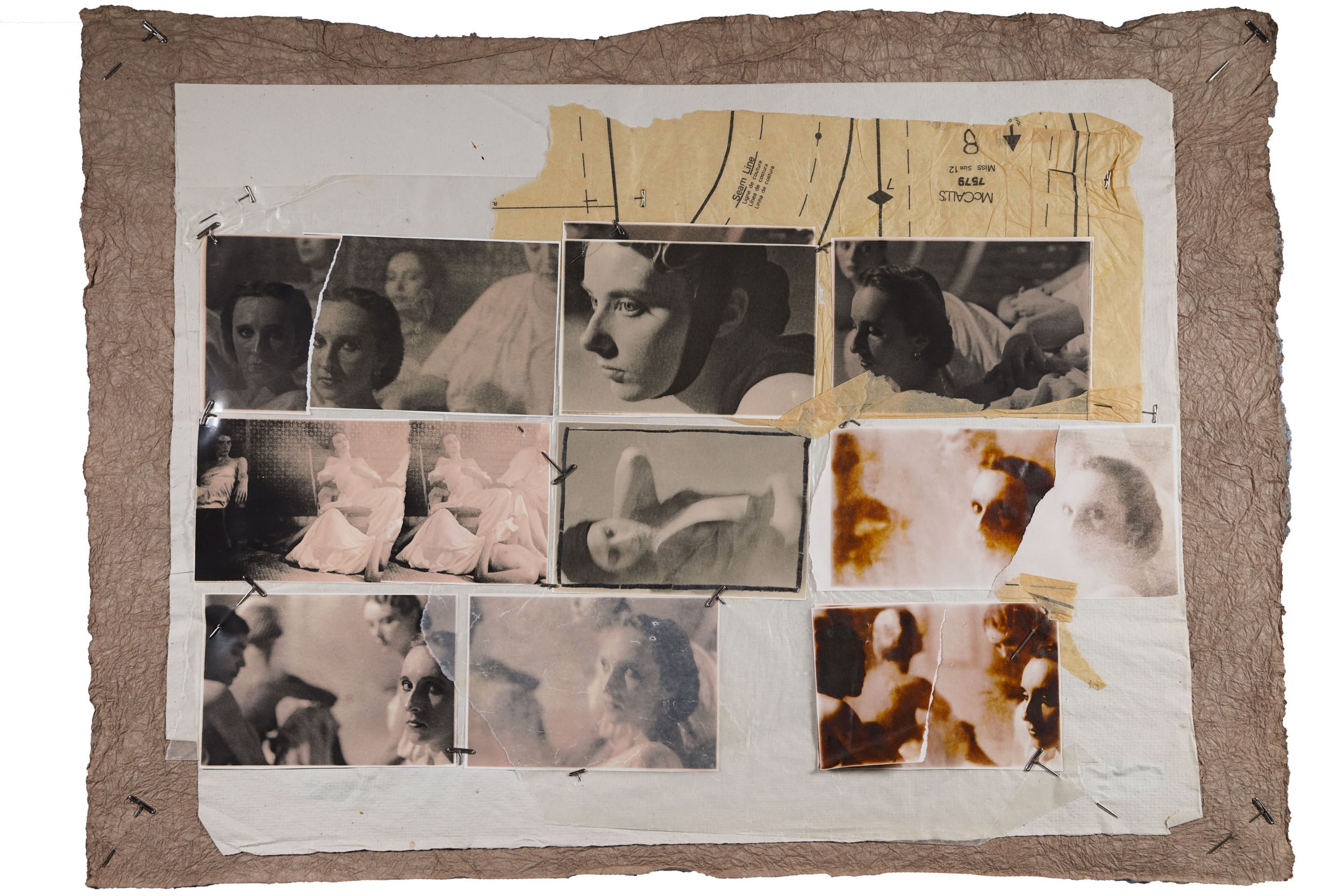

© Deborah Turbeville / MUUS Collection
In my research for this exhibition, I came across de Blauwer’s series Fugue, whose title struck me as serendipitous. The word ‘fugue’ has two meanings, one psychological and one musical, both of which perfectly resonate here. A "dreamlike altered state of consciousness” evokes the emotionally charged figures in their work, and a “melody introduced by one part, successively taken up by others and developed into interweaving parts," beautifully encapsulates the dynamic relationship between these two extraordinary artists.
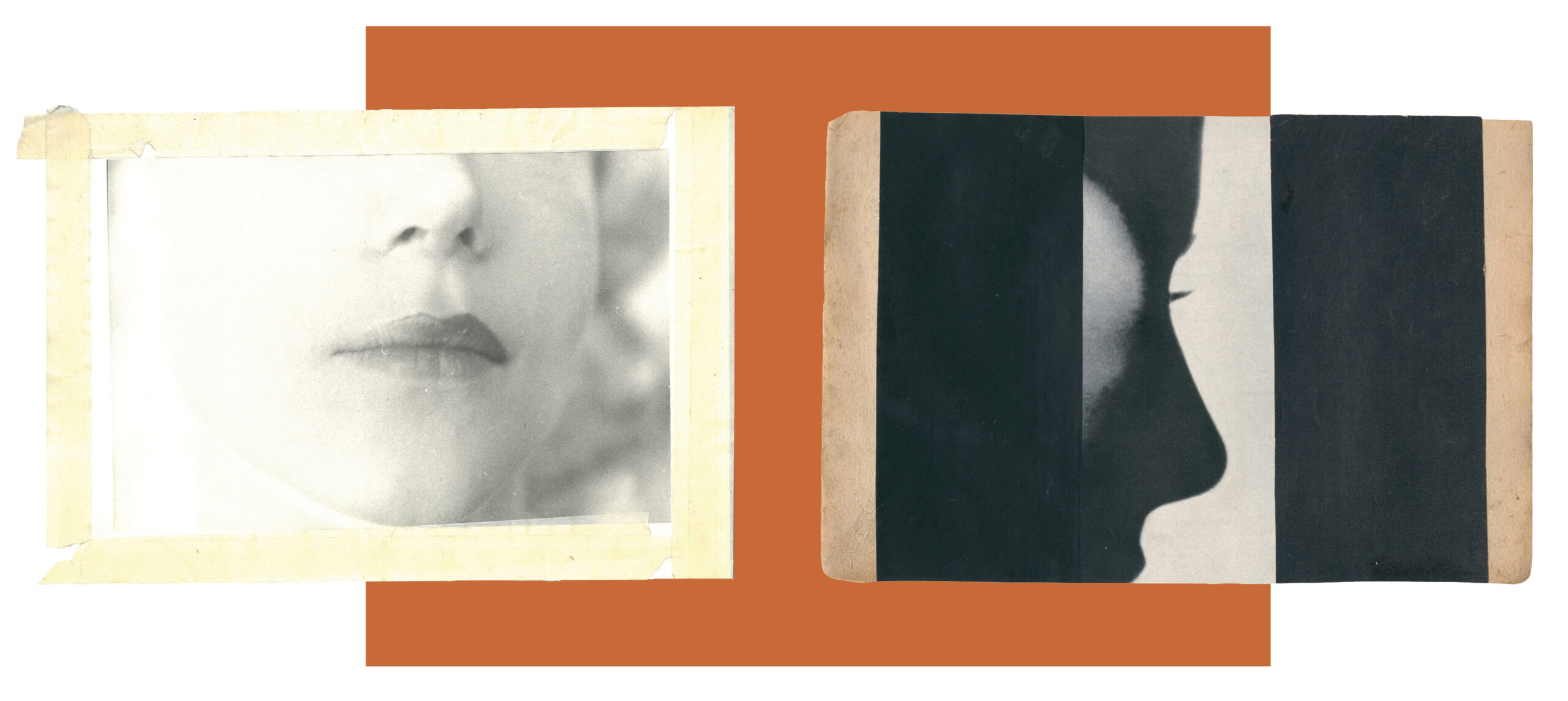
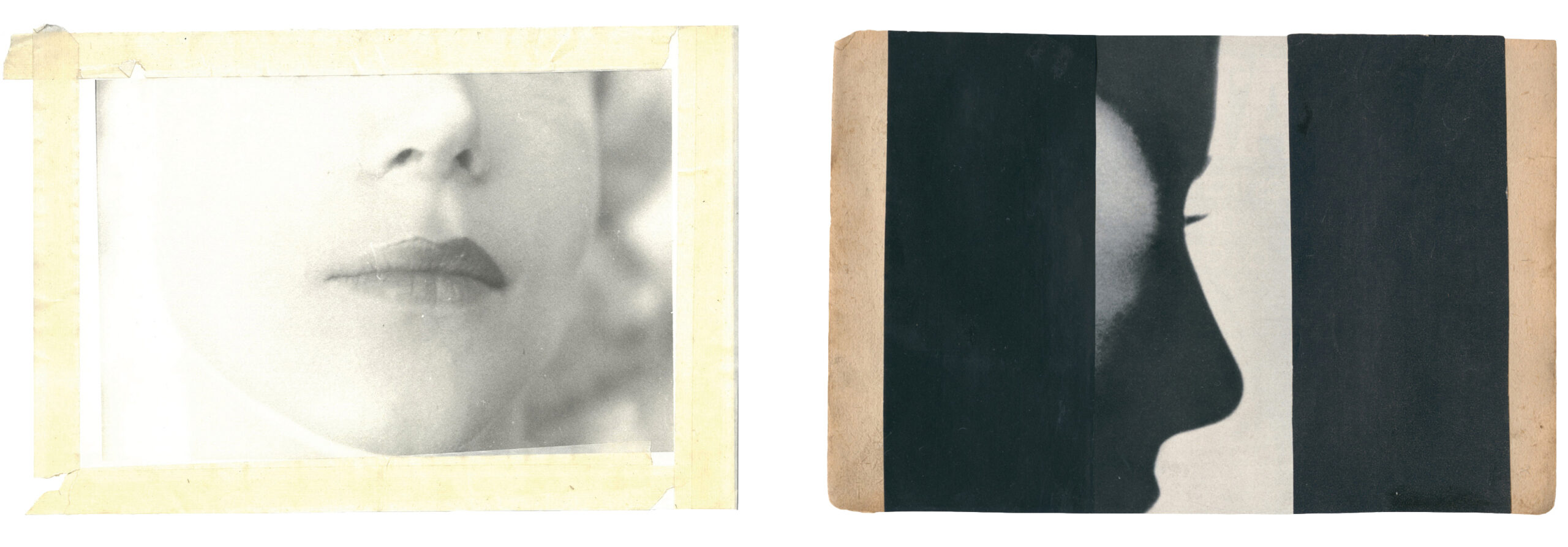
Deborah Turbeville (left)
Untitled (Ella Milewicz), from the series 'L'École des Beaux Arts', Paris, 1977
© Deborah Turbeville / MUUS Collection
Katrien de Blauwer (right)
'Fuge 1', ca. 2013
Courtesy of Galerie Les Filles du Calvaire, Paris
© Katrien de Blauwer
This online exhibition was created in close collaboration with MUUS Collection, Katrien de Blauwer and Galerie Les Filles du Calvaire. With creative support from Torvits + Trench and Namrata Krishna. I would like to thank all of them for their support and trust.
MUUS COLLECTION
Since 2012, MUUS has focused on acquiring and preserving important photographic works that mark major turning points in American history. As a functional archive, MUUS builds and shares its outstanding collections of photography, generating new scholarship and understanding, while instigating interesting dialogues within the wider photography community.
LES FILLES DU CALVAIRE
Katrien de Blauwer’s gallery in Paris, Les Filles du Calvaire, was founded in 1996 at 17 rue des Filles du Calvaire in the Marais. In 2023, it opened a 2nd space at 21 rue Chapon. The gallery represents a diverse range of international contemporary artists working in a variety of mediums including photography, painting, sculpture, video and performance.
MUUS COLLECTION
Since 2012, MUUS has focused on acquiring and preserving important photographic works that mark major turning points in American history. As a functional archive, MUUS builds and shares its outstanding collections of photography, generating new scholarship and understanding, while instigating interesting dialogues within the wider photography community.
LES FILLES DU CALVAIRE
Katrien de Blauwer’s gallery in Paris, Les Filles du Calvaire, was founded in 1996 at 17 rue des Filles du Calvaire in the Marais. In 2023, it opened a 2nd space at 21 rue Chapon. The gallery represents a diverse range of international contemporary artists working in a variety of mediums including photography, painting, sculpture, video and performance.
For further information about the work of Katrien de Blauwer and Deborah Turbeville, please get in touch.